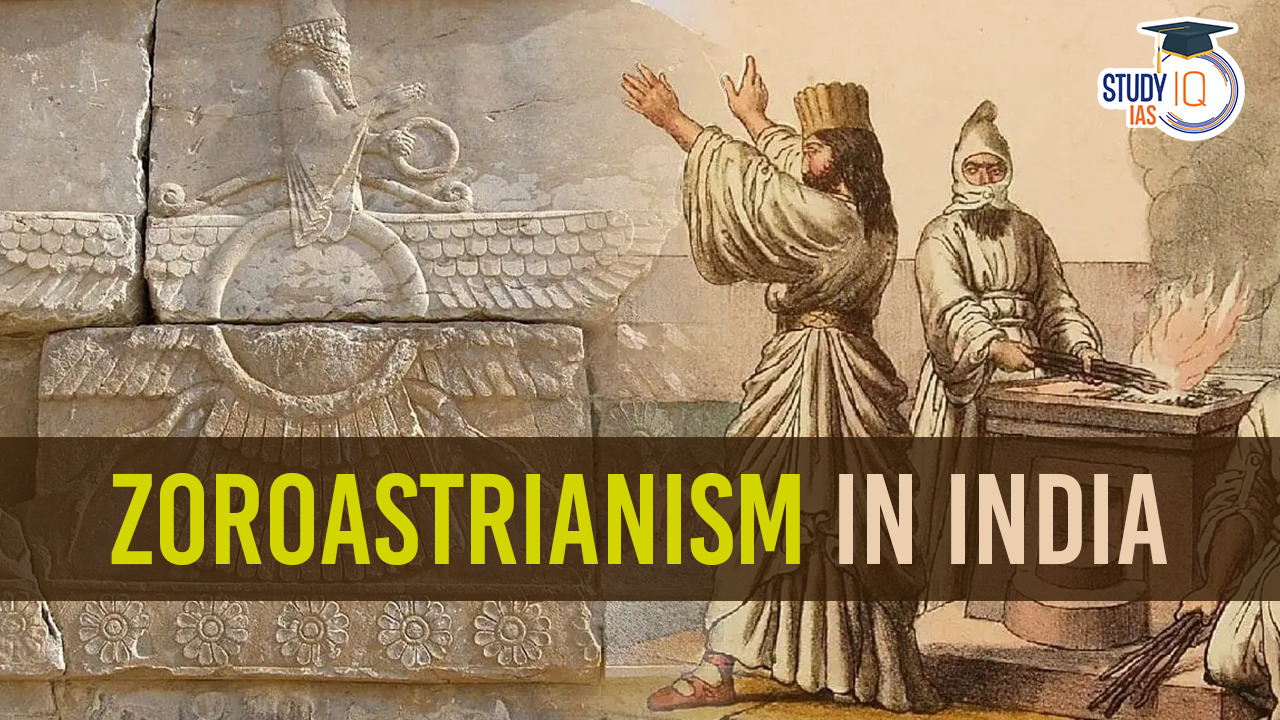Table of Contents
India is home to the world’s largest concentration of Zoroastrians, also known as Parsis. The Parsis are descendants of Zoroastrians from Iran who migrated to India to preserve their religion. Zoroastrianism in India is an ancient religion that shares a common root with Hinduism and has a history in India that goes back more than a thousand years.
We’re now on WhatsApp. Click to Join
History of Zoroastrianism
Achaemenid Empire (6th Century BCE)
Zoroastrianism flourished in Iran and Mesopotamia under Darius I. Alexander the Great’s invasion displaced Zoroastrianism, surviving in Cappadocia and the Caucasus.
Parthian Empire (3rd Century BCE)
Zoroastrianism experienced a revival in its land of origin.
Sassanid Empire
Zoroastrianism promoted aggressively. Conflicts with the Christianized Roman Empire.
Arab Conquest and Decline
Arab Conquest led to Zoroastrian decline in Persia. Gradual conversion of the pre-Islamic population.
Survival and Migration
Zoroastrianism survived in some regions but faced persecution. State policies compelled migration, notably to India.
Zoroastrianism in India
India hosts the largest concentration of Zoroastrians. Parsi community numbers around 70,000. Challenges include low birth rates and migration.
Contributions of Parsis in India
Noteworthy contributions in business, military, and the freedom struggle. Dadabhai Naoroji laid foundations for the Indian National Congress. Military contributions include Sam Manekshaw leading India to victory in the 1971 war.
Principle Beliefs of Zoroastrianism
Monotheism
Belief in one powerful cosmic entity, Ahura Mazda, often referred to as the ‘Lord of Light’ in Persian.
Messianism
Belief in a ‘messiah’ or savior who will bring eternal salvation and liberation to a chosen group of people.
Judgement after Death
Souls are judged by Ahura Mazda upon departing the earth, determining their passage to either heaven or hell.
Existence of Heaven and Hell
Zoroastrianism emphasizes the existence of distinct realms, with the righteous rewarded in heaven and the wicked facing consequences in hell.
Free Will
The concept that every individual possesses the ability to choose between different possible courses of action, highlighting the importance of personal responsibility.
Influence on Major Religions
Zoroastrianism’s philosophical beliefs may have influenced major religions like Christianity, Islam, and Buddhism.
Sacred Texts
The Avesta is the most important text in Zoroastrianism, containing central teachings known as the Gatha.
Places of Worship
- Fire temples, known as Dar-e Mehr (Persian) or Agiyari (Gujarati), serve as places of worship for Zoroastrians.
- Fire and clean water are regarded as agents of ritual purity in Zoroastrian religious practices.
Zoroastrian Communities in India
There are two primary Zoroastrian communities in India:
Parsi
- The term “Parsi” in Persian means “Persian,” reflecting the community’s Persian origins.
- The Parsis have a longstanding presence in the Gujarat and Sindh regions of India, as evidenced by genetic studies.
- The Parsi community in India is distinct from the smaller Zoroastrian Indian community known as Iranis.
Iranis
- The term “Irani” first appears during the Mughal era, but most Iranis arrived in the subcontinent during the 19th and early 20th centuries.
- Immigration occurred during the Qajar rule in Iran, marked by religious persecution of non-Muslims.
- Iranis are culturally and linguistically closer to Zoroastrians in Iran, particularly those from Yazd and Kerman.
- The Dari dialect, spoken in those Iranian provinces, is heard among the Irani community in India.
Zoroastrian Population in India
Zoroastrianism, one of the world’s oldest monotheistic religions, has a historical connection to India dating back to ancient times. Zoroastrians, often referred to as Parsis in the Indian context, arrived in the subcontinent centuries ago, seeking refuge from persecution in their native Persia (modern-day Iran). Over the years, they have become an integral part of India’s cultural and social fabric.
As of 2011, the percentage of the Indian population identifying as Zoroastrian was approximately 0.06 percent, a slight decrease from the 0.13 percent recorded in 1951. Despite being a small religious community in terms of numerical strength, the Parsis have made significant contributions to various facets of Indian society, including business, education, and the arts.
Challenges for Zoroastrianism in India
Dwindling population
The Parsi community’s population is declining, and some fear that authorities’ efforts to maintain the community’s purity will further reduce the number of practitioners. In 1971, the birth rate among Parsis was 10.6 per 1,000, compared to 41.2 for the general Indian population.
Social practices
Some Parsis have engaged in child marriage, bigamy, and the worship of non-Zoroastrian religious sites.
Religious discrimination and persecution
Zoroastrians have faced religious discrimination and persecution, harassment, and have been identified as “najis” (polluted) and impure to Muslims.
Late marriage, reluctance to marry, and health complications
These factors have contributed to the crisis within the community.
Jiyo Parsi scheme
The “Jiyo Parsi” scheme is an initiative by the Government of India aimed at addressing the demographic decline within the Parsi community. The Parsis, followers of the Zoroastrian faith, have faced concerns about a declining population in India, and the Jiyo Parsi scheme was launched to encourage Parsi couples to have more children and address the community’s shrinking numbers.
The scheme was initiated by the Ministry of Minority Affairs and was launched in September 2013. The term “Jiyo Parsi” translates to “Live Parsi,” and the program focuses on both financial and emotional support to Parsi couples to promote family planning and increase the community’s population. The decline in the Parsi population is attributed to factors such as late marriages, smaller family sizes, and a high rate of migration.
Zoroastrianism in India UPSC
Despite valuable contributions, India’s Parsi community faces challenges such as declining population due to low birth rates, inter-community marriages, and emigration. Internal efforts promote marriage and family planning, aiming to counter this decline. Concurrently, initiatives focus on preserving Zoroastrian heritage and religious practices. Despite a small population, the vibrant Zoroastrian community has made a lasting impact on India’s social, economic, and cultural landscape, leaving an indelible mark that transcends numerical size. The Parsis, with their rich cultural and historical legacy, continue to play a significant role in shaping India’s diverse tapestry.


 Chittorgarh Fort: Mining Ban within 10 k...
Chittorgarh Fort: Mining Ban within 10 k...
 PM Modi visits Wat Pho Temple in Bangkok
PM Modi visits Wat Pho Temple in Bangkok
 Mahabodhi Temple Complex at Bodh Gaya
Mahabodhi Temple Complex at Bodh Gaya





















